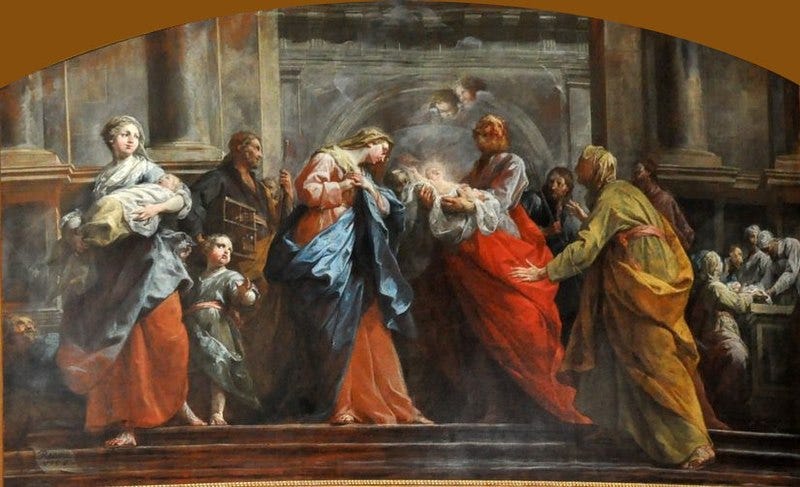Purification of Mary? Do her a favour...
George Pitcher offers a feminist take on today's Presentation of Christ at the Temple
Today is the Feast of the Purification of the Blessed Virgin Mary. And February 2nd is a Church festival that sits uncomfortably with readers of reformational feminist theology. Why exactly should the Mother of God – or any mother for that matter – need to be “purified” after childbirth by the patriarchy at the Temple?
The Church over the centuries came to call it liturgically the Churching of Women (again, the Churching done by men), in thanksgiving for childbirth. Little wonder it’s most widely known as Candlemas these days, with the blessing of candles eclipsing the purifying of female blood.
Presentation of Christ
More of that blood in a moment. Meanwhile, it’s also called the Presentation of Christ at the Temple, when in keeping with ancient Jewish custom the infant Jesus is blessed with a holocaust (in this sense, a burnt offering as a sacrifice on the altar).
But what if we’re missing something here, by concentrating on the Christ child in this scriptural event, along with the Temple patriarchy, represented by Simeon and his song of covenantal completion – most famously known as the Nunc Dimittis: “Lord, now lettest thou thy servant depart in peace according to thy word.”
Powerful womanhood
If there is something fundamentally powerful about womanhood, isn’t it worth teasing out? To do so is neither revisionist nor anachronistic, since the apostle Luke is not only the sole gospel author of this episode but also the writer of the Acts of the Apostles, in which he takes care to record the powerful witness of notable female disciples such as Lydia, Damaris and Priscilla.
At the Presentation at the Temple, in this context, it’s first worth diverting attention from the presentee (the Christ child) to the presenter (Mary). She holds the trump in her hand; Simeon addresses her, not Jesus’s non-biological father, who barely gets a look-in.
Mary’s power is in her Christ-like humility. Spotless, immaculate, “undefiled” by a man and therefore needing no purification, she nonetheless submits to the ritual law. In this act, she precedes Jesus’s own meek submission to baptism by John, rather than the other way around.
Sacrificial gifts
Her sacrificial gifts, the poor person’s offering of “a pair of doves or two young pigeons” stand in stark counterpoint to the opulence of the Magi’s contributions. She is then, perhaps, offering the luxuriant Temple authorities their own epiphany.
In so doing, Mary’s presence purifies the Temple, rather than the reverse, just as her child as a grown man will cleanse the Temple by humiliating the fraudulent money-changers there, who profit from sacrificial offering (so also may have ripped off Mary three decades previously).
Note also that the old man Simeon, in addressing Mary, prophesies that “a sword will pierce you own soul, that the thoughts of many hearts may be revealed”. This most usually refers to her suffering and sorrow at the cross. So it may. But two further thoughts on what it might mean for the power of Mary.
Sacred heart
First, there is the Sacred Heart tradition in Catholic devotion, which depicts the heart of the Christ, shining with divine light (at least in Renaissance art), pierced by a lance and bleeding, as he was stabbed on the cross to hasten death. The words of Simeon imbue the Mother of God’s heart (and soul) with similar status.
Second, blood from the wounded soul of Mary seems of a different order to her woman’s blood, from which she apparently comes to be purified by the Temple. Again, Mary is the purifier, not the Temple. Or, rather, her body becomes the Temple of Christ.
Prophetess
Then there is Anna, a prophetess, also of a great age, who comes late in the scene and speaks of the Christ child “to all who were looking forward to the redemption of Jerusalem.” A word most regularly used in scholarship about Anna (“from the tribe of Asher”) is “puzzling”. She is the only Jewish character in the New Testament who doesn’t belong to the tribe of Judah, Benjamin or Levi, but to one of the northern tribes of Israel.* What’s she doing here?
One reason may be that she represents the wider diaspora of the Jewish people, contrasting with the Temple-centric Jerusalem devotees fronted by Simeon. That would be a pre-echo of the Christ’s mission to the Gentiles. But another, simpler explanation may be that she’s a woman and a stranger, as such the first appearance of a new womanism, after Mary, in the gospel. Anna is the outsider.
Allegorical
A great deal can be (and is) made of the strong possibility that the narrative of the Presentation is allegorical (though equally strong cases can be made for the historicity of Simeon and Anna). But that really doesn’t matter in exegetical terms.
What does matter is that Mary, both literally and metaphorically as we have seen, is at the heart of the narrative, not simply the obedient progenitor of the Christ child and therefore the story.
The words of Simeon to her and the strange appearance of Anna put the female firmly at the start of the Jesus revolution, even if it will spawn a Church that for centuries will try, ultimately unsuccessfully, to bury women’s witness.
* I am indebted here to Richard Bauckham’s Gospel Women, Eerdmans, 2002
George Pitcher is a visiting fellow at the LSE and an Anglican priest




